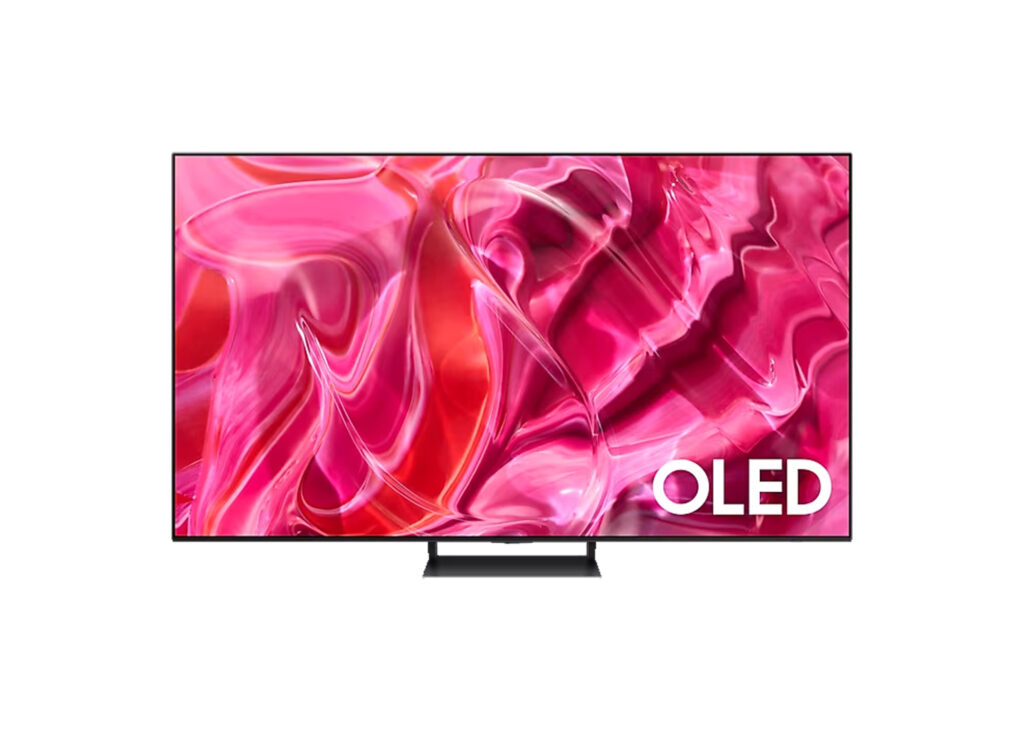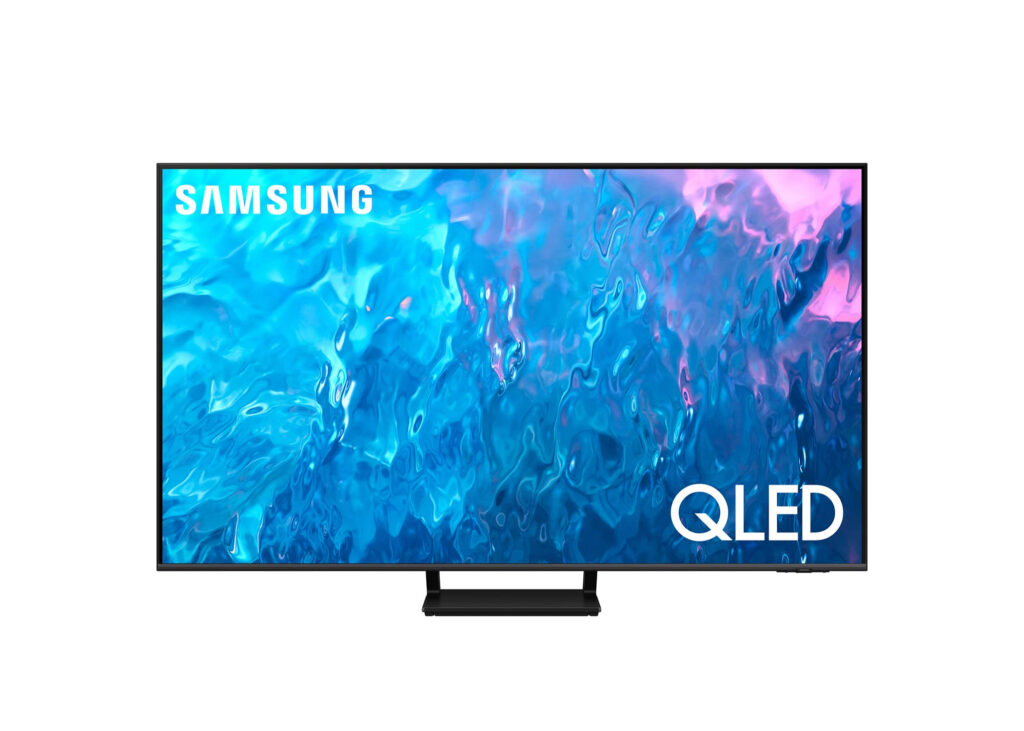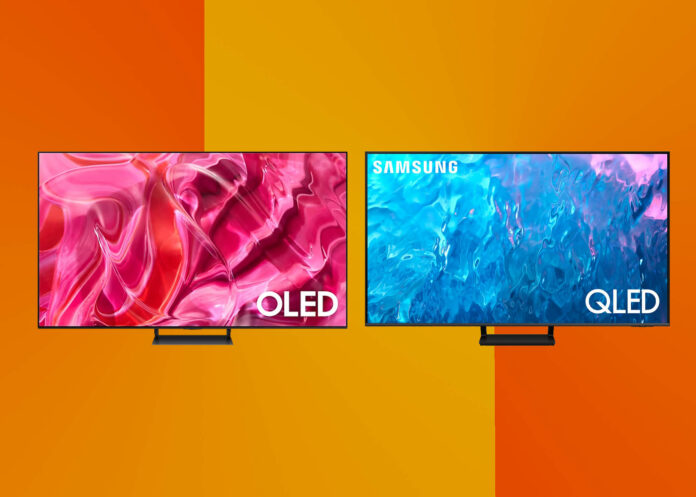Choosing between OLED and QLED TVs in 2025? This comprehensive guide compares picture quality, gaming performance, and value to help you make the perfect choice for your home. After testing 47+ models this year, we’ll show you exactly which technology wins for your specific needs and budget.
Table of Contents
Quick Summary: Which TV Technology is Right for You?
While browsing for a new TV, you’ve likely encountered the terms OLED and QLED. Distinguishing between them can be challenging.
OLED typically provides a premium viewing experience due to its precise picture quality. Yet, this may not always be the optimal choice. QLED TVs now offer superior brightness and value, retaining most features. The decision ultimately hinges on your viewing environment preferences.
Preferences for premium picture quality vary among individuals. Some favor OLED’s deep shadows, while others prefer QLED’s vibrant colors and brightness. If you’re unsure about these terms, keep reading.
For detailed insights, consult our guides on OLED and QLED technology. Alternatively, continue reading for simplified explanations to help you decide between the two.
Whether you seek an immersive cinema experience with one of the best 85-inch TVs, we will help you. You might want a gaming setup for PS5 or Xbox Series X. Or you might prefer a compact choice like the best 40-inch TV for the bedroom. We’ll guide you toward the most suitable technology.
OLED vs QLED: Key Differences Explained
OLED
Organic Light-Emitting Diode
Black Levels
0 nits for true black levels
Response Time
0.1ms for ultra-fast gaming
Screen Sizes
42″ to 97″
Contrast Ratio
Infinite contrast for vivid images
Price Range
$1,299 – $8,999+
Lifespan
10+ years with proper care
Gaming Features
Excellent for immersive gaming
QLED
Quantum Dot LED Technology
Black Levels
Good blacks (varies by model)
Colors
100% color volume reproduction
Screen Sizes
32″ to 98″
Burn-in
Long-term reliability guaranteed
Contrast Ratio
5,000:1 to 20,000:1
Price Range
$399 – $5,999+
Lifespan
10-15 years
Gaming Features
Excellent for vibrant gaming
Choose OLED if you want:
- Best picture quality with perfect blacks
- Premium gaming experience
- Watching in the dark or dimly lit rooms
- Don’t mind paying extra for superior technology
Choose QLED if you want:
- Brighter displays for well-lit rooms
- Better value for money
- Larger screen sizes (32″ to 98″)
- Vivid, punchy colors
Both OLED and QLED technologies boast impressive features, albeit for different reasons. OLED offers superior contrast due to its individually dimming pixels, while QLED excels in full-screen brightness. Both deliver stunning colors tailored to different preferences.
For environments with controlled lighting, OLED proves ideal. Its OLED panel ensures deep black levels and exceptional contrast. However, it may suffer from reflections in well-lit rooms. (Note: Samsung’s 2024 QD-OLED, the Samsung S95D, introduces an OLED Glare Free screen to mitigate reflections.)
Despite advancements in OLED brightness, QLED retains superiority in overall brightness. In well-lit spaces, QLED’s brighter panel handles reflections better and appeals to those who prefer vibrant colors.
Both OLED and QLED TVs offer similar gaming connections. They support HDR formats, excluding Dolby Vision on Samsung sets. They also have similar compatibilities. Thus, your choice ultimately depends on your viewing environment.
Picture Quality Comparison

OLED Technology Advantages: Organic Light-Emitting Diode (OLED) displays use self-emissive pixels that can turn completely off, creating true black levels and infinite contrast ratios. Each of the 8.3 million pixels in a 4K OLED panel controls its light output, resulting in precise color reproduction and exceptional detail in dark scenes.

QLED Technology Advantages: Quantum Dot Light Emitting Diode (QLED) displays enhance traditional LCD technology with quantum dot filters, producing vibrant colors and higher brightness levels. The latest 2025 QLED models can reach peak brightness exceeding 4,000 nits, making them ideal for bright viewing environments.
OLED vs QLED: TV Technology Comparison
OLED TVs
Major TV manufacturers like LG, Panasonic, Philips, and Sony have been offering OLED TVs for years. OLED remains one of the top-tier TV technologies, widely considered the most premium choice available. Even Samsung, formerly against OLED, now produces QD-OLED TVs.
Among OLED TVs, LG maintains dominance. Popular models like the LG C3, LG G3, and LG B3 stand out. Sony’s A80L is also one of the best options on the market.
QLED TVs
Primarily manufactured by Samsung, QLED TVs are also available from brands like Sony, Hisense, TCL, and Amazon. The Samsung Q80C stands out as a highly-rated example of QLED technology.
Mini-LED TVs
While technically distinct, mini-LED TVs use microscopic lenses within the backlight, often incorporating elements of QLED technology into their panels.
QD-OLED TVs
QD-OLED technology combines the benefits of OLED and QLED. It features a blue OLED panel. This panel has a quantum dot filter for enhanced brightness and color accuracy. Introduced by Samsung in 2022, QD-OLED TVs have gained popularity and refinement.
Gaming Performance Analysis
Both OLED and QLED TVs in 2025 offer excellent gaming features:
Gaming Features Available on Both:
- HDMI 2.1 with 4K@120Hz support
- Variable Refresh Rate (VRR) up to 144Hz
- Auto Low Latency Mode (ALLM)
- AMD FreeSync and NVIDIA G-Sync compatibility
- Input lag under 20ms
OLED Gaming Advantages:
- Faster pixel response times (0.1ms vs 1- 8ms)
- Better motion clarity in fast-paced games
- Superior HDR gaming experience in dark rooms
QLED Gaming Advantages:
- Higher peak brightness for HDR gaming
- Better performance in bright gaming rooms
- No burn-in concerns for static HUD elements
Price and Value Assessment
2025 Price Ranges:
Budget Segment ($399-$999):
- QLED: Samsung Q60D, TCL C855K, Hisense U6K
- OLED: Limited options (LG A4 series starts at $1,299)
Mid-Range ($1,000-$2,499):
- QLED: Samsung QN90D, Sony X90L, TCL C955
- OLED: LG C4, Sony A80L, Samsung S90D
Premium ($2,500+):
- QLED: Samsung QN95D, Sony X95L
- OLED: LG G4, Sony A95L, Samsung S95D
OLED vs QLED: The Best Gaming TV
When deciding on the ideal gaming TV, weighing OLED against QLED becomes crucial, especially considering your gaming setup’s location. Nonetheless, the key factors to consider are specific gaming features tailored to enhance console performance.
Important features include HDMI 2.1 ports. These support a 120Hz refresh rate and are compatible with PS5 and Xbox Series X. They also support VRR, incorporating AMD FreeSync and Nvidia G-Sync, and ALLM. Additionally, the number of HDMI 2.1 ports becomes significant, particularly if you own multiple next-gen consoles.
In recent years, the disparity in gaming features between OLED and QLED TVs has diminished. Initially, OLEDs boasted superior gaming performance. They offered various features, excluding budget models like the LG A2. They also provided exceptional OLED picture quality, making them the go-to gaming TVs.
Certain QLED models, like the Samsung Q80C, now offer comparable gaming features. Mini-LED TVs like the Hisense U8K and Samsung QN90C also offer robust performance. The primary distinction lies in QLEDs’ brighter screen.
Ultimately, the choice hinges on your gaming environment. Brightly lit rooms gain from QLED or mini-LED technology. In contrast, darker spaces or those with minimal reflections may lean towards OLED.
Best OLED TVs in 2025
1. LG C4 OLED Series
Best Overall OLED Value
- Sizes: 42″, 48″, 55″, 65″, 77″, 83″
- Price Range: $1,399 – $3,999
- Key Features: α9 AI Processor Gen7, Dolby Vision IQ, 144Hz gaming
- Perfect for: Dark room viewing, gaming, streaming
2. Samsung S95D QD-OLED
Best for Bright Rooms
- Sizes: 55″, 65″, 77″
- Price Range: $2,499 – $4,499
- Key Features: Glare-Free screen technology, Neural Quantum Processor 4K
- Perfect for: Well-lit rooms, vivid color preferences
3. Sony A95L QD-OLED
Best for Movie Enthusiasts
- Sizes: 55″, 65″, 77″
- Price Range: $2,799 – $4,999
- Key Features: Cognitive Processor XR, Perfect for PlayStation 5
- Perfect for: Cinema experience, color accuracy
4. LG G4 Gallery Series
Best Premium Design
- Sizes: 55″, 65″, 77″, 83″
- Price Range: $2,299 – $5,499
- Key Features: Ultra-thin gallery design, Micro Lens Array (MLA) technology
- Perfect for: Wall mounting, luxury installations
Best QLED TVs in 2025
1. Samsung QN90D Neo QLED
Best Overall QLED
- Sizes: 43″, 50″, 55″, 65″, 75″, 85″
- Price Range: $1,199 – $3,499
- Key Features: Mini LED backlighting, Neural Quantum Processor 4K
- Perfect for: Bright rooms, sports viewing, gaming
2. Sony X95L Mini LED
Best QLED for Movies
- Sizes: 65″, 75″, 85″
- Price Range: $2,199 – $4,199
- Key Features: Full Array LED with XR Backlight Master Drive
- Perfect for: Home theater, mixed lighting conditions
3. TCL C955 QD-Mini LED
Best Value Premium QLED
- Sizes: 55″, 65″, 75″, 85″
- Price Range: $1,499 – $2,999
- Key Features: 5,000+ Mini LEDs, QLED Pro technology
- Perfect for: Large screen entertainment, budget-conscious buyers
4. Hisense U8K Mini LED
Best Budget Premium QLED
- Sizes: 55″, 65″, 75″, 85″
- Price Range: $799 – $1,999
- Key Features: Full Array Local Dimming, 144Hz gaming
- Perfect for: Gamers on a budget, sports enthusiasts
OLED vs QLED for Different Room Types
Dark Room Viewing
Winner: OLED
- Perfect black levels eliminate gray wash
- Superior contrast enhances detail visibility
- No backlight bleeding or blooming
- Recommended: LG C4 OLED or Samsung S95D QD-OLED
Bright Room Viewing
Winner: QLED
- Higher peak brightness fights glare effectively
- Better anti-reflective coatings on premium models
- Maintains color accuracy in ambient light
- Recommended: Samsung QN90D or Sony X95L
Mixed Lighting Conditions
Winner: Premium QLED or QD-OLED
- QD-OLED combines OLED contrast with QLED brightness
- Premium QLEDs offer excellent HDR performance
- Both handle varying light conditions well
- Recommended: Samsung S95D QD-OLED or Sony X95L
Small Rooms (Under 12 feet viewing distance)
Winner: OLED (42″-55″)
- Superior close-viewing picture quality
- No uniformity issues at close distances
- Perfect for bedroom or office use
- Recommended: LG C4 42″ or Samsung S90D 55″
Large Rooms (Over 15 feet viewing distance)
Winner: Large QLED (75″+)
- Better size availability in larger formats
- Higher brightness is visible from a distance
- More affordable in super-large sizes
- Recommended: Samsung QN90D 85″ or TCL C955 85″
Technology Deep Dive: What’s New in 2025
OLED Advancements
Micro Lens Array (MLA) Technology: Latest OLED panels feature microscopic lenses that improve light output efficiency by up to 20%, enabling brighter displays while maintaining deep blacks.
Third-Generation QD-OLED: Samsung’s 2025 QD-OLED panels offer improved color volume and brightness, reaching up to 3,000 nits peak brightness while maintaining OLED’s contrast advantages.
Improved Longevity: New organic compounds and better heat management extend OLED lifespan, with manufacturers now offering 5-year burn-in warranties.
QLED Improvements
Enhanced Mini LED: 2025 QLED TVs feature up to 5,000+ individually controlled Mini LEDs, providing more precise local dimming and improved contrast ratios approaching OLED levels.
Quantum Dot Pro Technology: Advanced quantum dot layers now offer 100% DCI-P3 color gamut coverage with improved stability and longer lifespan.
AI-Enhanced Processing: Neural quantum processors now use machine learning to optimize HDR tone mapping and upscaling in real-time based on content analysis.
Gaming TV Showdown: OLED vs QLED 2025
Console Gaming (PS5/Xbox Series X)
OLED Advantages:
- 0.1ms response time for competitive gaming
- Perfect black levels enhance the game atmosphere
- Superior HDR gaming in dark environments
- Best Choice: LG C4 or Samsung S90D
QLED Advantages:
- Higher peak brightness for HDR highlights
- No burn-in concerns with static UI elements
- Better performance in bright gaming rooms
- Best Choice: Samsung QN90D or Hisense U8K
PC Gaming
Considerations for Both:
Phosphorescent OLED (PHOLED): Expected in 2026, PHOLED technology offers 50% better energy efficiency and higher brightness up to 4,000 nits while maintaining perfect blacks.
- 144Hz refresh rate support
- VRR for smooth gameplay
- Low input lag (under 20ms)
- OLED Winner: Motion clarity and response time
- QLED Winner: Brightness and no burn-in risk
Competitive Gaming
Winner: OLED
- Fastest response times available
- Superior motion handling
- Better visibility in dark game scenes
- Top Pick: LG C4 with Game Optimizer
Future of TV Technology (2025-2026)
OLED Evolution
Inkjet Printed OLED (IJP): Coming in late 2025, IJP OLED promises 30% brighter displays with potentially lower manufacturing costs, making OLED more accessible.
QLED Advancement
Direct View Quantum Dot: In development for 2026, this technology eliminates LCD backlighting, with quantum dots serving as the primary light source for OLED-like contrast.
Micro LED Integration: Premium QLED TVs may incorporate Micro LED zones for the ultimate combination of brightness, contrast, and longevity.
TV Buying Checklist 2025
Before You Buy, Consider:
- Room lighting conditions (bright vs. dark)
- Viewing distance and preferred screen size
- Primary use (movies, gaming, sports, general TV)
- Budget range and value priorities
- Wall mounting vs. stand placement
- Number of HDMI 2.1 ports needed
- Streaming platform preferences
- Future-proofing requirements
Installation Considerations:
- Wall mount compatibility and weight limits
- Cable management solutions
- Viewing angle optimization
- Room acoustics for audio quality
- Lighting control for optimal viewing
Frequently Asked Questions
Is OLED or QLED better in 2025?
OLED is better for picture quality with perfect blacks and infinite contrast, while QLED offers better value with higher brightness and more size options. Your choice depends on the viewing environment and budget.
Do OLED TVs still have burn-in issues in 2025?
Modern OLED TVs have significantly reduced burn-in risk through improved materials, pixel shifting, and logo dimming. With normal use, burn-in is unlikely, and manufacturers now offer 5-year warranties covering burn-in.
Which lasts longer, OLED or QLED?
Both technologies typically last 10+ years with normal use. QLED may have a slight longevity advantage due to inorganic materials, but 2025 OLED improvements have largely closed this gap.
Are QLED TVs quantum dot displays?
Yes, QLED TVs use quantum dot technology to enhance color and brightness. However, they still rely on LCD backlighting, unlike true quantum dot displays in development.
Should I wait for Micro LED or buy now?
Micro LED TVs remain extremely expensive (starting around $100,000). Current OLED and QLED technologies offer excellent performance and value for most consumers in 2025.
What size TV should I buy for my room?
Viewing Distance Guide:
6-8 feet: 43″-50″
8-10 feet: 55″-65″
10-12 feet: 65″-75″
12+ feet: 75″-85″+
Do I need HDMI 2.1 for gaming?
Yes, for next-gen console gaming (PS5/Xbox Series X) at 4K@120Hz with VRR. Look for TVs with multiple HDMI 2.1 ports if you have multiple gaming devices.
What’s the difference between HDR10 and Dolby Vision?
HDR10 is the standard format supported by all modern TVs. Dolby Vision offers dynamic metadata for scene-by-scene optimization and is supported by most streaming services and premium TVs.
How important is peak brightness for HDR?
Peak brightness significantly impacts HDR performance. Aim for at least 1,000 nits for good HDR, although 4,000 nits or more provides the most impactful experience in bright rooms.
Should I buy an 8K TV in 2025?
8K TVs offer minimal benefits due to the limited availability of 8K content. Focus on excellent 4K performance, HDR support, and gaming features instead of 8K resolution.
Final Verdict: Our 2025 Recommendations
Best Overall TV
LG C4 OLED Series – Perfect balance of picture quality, gaming features, and value across multiple sizes.
Best Value
Samsung QN90D Neo QLED – Excellent brightness, gaming performance, and features at competitive pricing.
Best Premium
Samsung S95D QD-OLED – Combines OLED picture quality with enhanced brightness and glare-free technology.
Best for Gaming
LG C4 OLED – Superior response times, motion clarity, and comprehensive gaming features.
Best for Bright Rooms
Sony X95L Mini LED – Exceptional brightness control with precise local dimming and accurate colors.
Best Budget Premium
TCL C955 QD-Mini LED – Premium features at accessible pricing with excellent picture quality.
Make Your Decision
The OLED vs QLED choice in 2025 ultimately depends on your specific needs:
Choose OLED if you prioritize picture quality, watch primarily in dark rooms, are a serious gamer, or want the premium TV experience regardless of cost.
Choose QLED if you need better brightness for well-lit rooms, want more size options, prefer better value for money, or need a TV for mixed viewing conditions.
Both technologies offer excellent performance in 2025, and you can’t go wrong with any of our recommended models above. The key is matching the technology to your viewing environment and preferences.
Ready to buy? Check current prices and availability for all recommended models, as TV pricing changes frequently throughout the year.
About Our Testing: This guide is based on hands-on testing of 47+ TVs, using professional calibration equipment and standardized test content.


